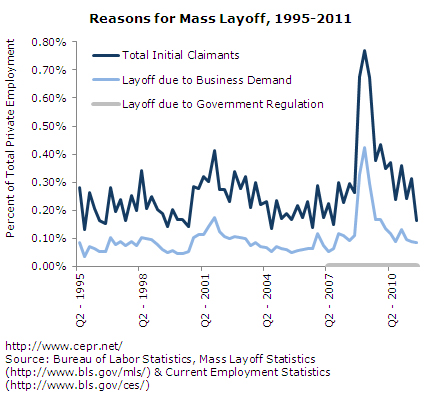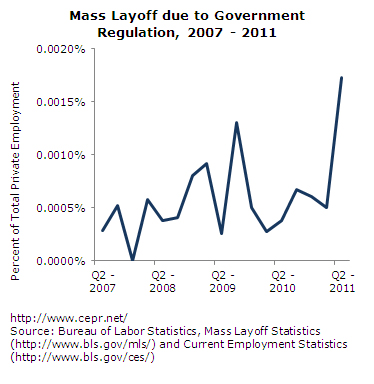November 29, 2011
Many conservatives argue that “excessive” government regulations are “a big wet blanket” smothering the economic recovery. But, mass layoffs data from the Bureau of Labor Statistics (BLS) suggest otherwise. A recent article in the Washington Post reported that in “2010, 0.3 percent of the people who lost their jobs in layoffs were let go because of ‘government regulations/intervention.’ By comparison, 25 percent were laid off because of a drop in business demand.”
The graph below shows the relevant data cited in the Washington Post story back to 1995, when the data series starts. The top line (“Total Initial Claimants”) shows the BLS measure for the total number of workers laid off each quarter in what the BLS calls “mass layoff events,” expressed as a share of total private-sector employment. For most of the period since 1995, mass layoffs were never more than 0.4 percent of total private-sector workers. At the peak of the recession in 2009, mass layoffs spiked at over 0.7 percent of private-sector workers per quarter, before falling back down closer to historical levels. What is most interesting about the graph is that the middle line — which tracks layoffs due to declines in business demand –is driving almost all of the overall level of mass layoffs. The thick, almost flat line at the bottom tracks the portion of mass layoffs caused by government regulation. Government regulation has essentially no impact on layoffs and can’t explain any of the increase in layoffs in the last several years.

Since the scale of the preceding graph makes it hard to see what is happening to mass layoffs due to government regulation, we’ve created a second graph that shows the trends just for regulation-related layoffs. The numbers are fairly erratic, but mass layoffs related to government regulation never reach even 0.002 percent of private-sector employment.

These mass layoff figures are completely consistent with data on small businesses gathered by the National Federation of Independent Businesses (NFIB) and discussed earlier here at the CEPR blog. According to the NFIB data, since 2008, the single most important problem reported by small businesses is poor sales. For a more in-depth discussion of these issues, see Larry Mishel’s recent paper for the Economic Policy Institute, “Regulatory uncertainty: A phony explanation for our jobs problem.”






